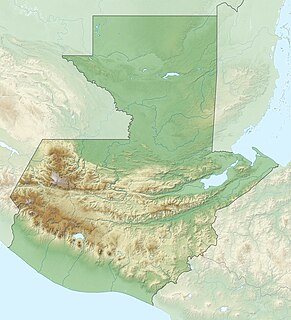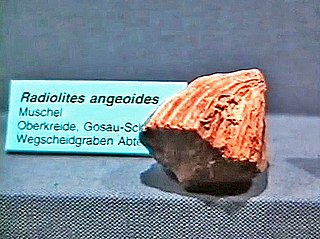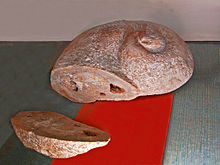The Cretaceous is a geological period that lasted from about 145 to 66 million years ago (Mya). It is the third and final period of the Mesozoic Era, as well as the longest. At around 79 million years, it is the longest geological period of the entire Phanerozoic. The name is derived from the Latin creta, "chalk", which is abundant in the latter half of the period. It is usually abbreviated K, for its German translation Kreide.

Macrofossils, also known as megafossils, are preserved organic remains large enough to be visible without a microscope. The term macrofossil stands in opposition to the term microfossil. Microfossils, by contrast, require substantial magnification for evaluation by fossil-hunters or professional paleontologists. As a result, most fossils observed in the field and most "museum-quality" specimens are macrofossils.

Rudists are a group of extinct box-, tube- or ring-shaped marine heterodont bivalves belonging to the order Hippuritida that arose during the Late Jurassic and became so diverse during the Cretaceous that they were major reef-building organisms in the Tethys Ocean, until their complete extinction at the close of the Cretaceous.

Hippurites is an extinct genus of rudist bivalve mollusc from the Late Cretaceous of Africa, Asia, Europe, North America, and South America.

Megalodon is an extinct genus of bivalve molluscs that reportedly lived from the Devonian to the Jurassic period. It is not clear, however, that all the fossils assigned to Megalodon from that span of time really belong in the same genus. Jurassic relatives of Megalodon such as Pachyrisma grande were closely related to the rudists.
Polazzodus is an extinct pycnodontid from the late Cretaceous of the Polazzo locality of northeastern Italy. The paleoenvironment of Polazzo was a large marine carbonate platform and shallow internal lagoons formed from rudist reefs. P. coronatus is known from numerous specimens, many of which were very well-preserved.
The Garzan oil field is an oil field located in Batman, Batman Province, Southeastern Anatolia Region. It was discovered in 1947–1951 and developed by Türkiye Petrolleri Anonim Ortaklığı. It began production in 1956. The total proven reserves of the Garzan oil field are around 163 million barrels (22.2×106 tonnes), and production is about 1,700 barrels per day (270 m3/d). The structure is a double plunging anticline bordered by a major reverse fault extending along the southern flank. The age of the Garzan formation is cretaceous, consisting of carbonates of a rudist build-up complex. Oil field contains 24 degree API (0.91 g/cm3) oil with a reservoir viscosity of 6.75 cp. Reservoir was initially highly undersaturated lists basic reservoirdata for Garzan.

Requienia is an extinct genus of fossil saltwater clam, a marine bivalve molluscs in the order Hippuritida, family Requieniidae. These rudists lived in the Cretaceous period, from the Valanginian age (136.4–140.2) to the Campanian age. They were stationary intermediate-level suspension feeders.

Caprinidae is a family of rudists, a group of unusual extinct saltwater clams, marine heterodont bivalves in the order Hippuritida.

The Sierra Madre Formation is a geologic formation in Chiapas state, southern Mexico. It consists of marine dolomites and limestones. The formation dates to the Middle Cretaceous, spanning from the Aptian of the Early to the Cenomanian of the Late Cretaceous.

The Campur Formation (Kca) is a geologic formation of the Petén Basin of northern Guatemala. The subtidal limestone preserves fossils dating back to the Late Cretaceous period.

The Peters Hill Limestone or Peters Hill Formation is a geologic formation in Jamaica. It preserves fossils such as rudists, echinoids and corals from the Santonian stage of the Cretaceous Period.
Requieniidae is a family of rudists, in the order Hippuritida, which lived from 155.7 to 66.043 million years ago.
The island of Bonaire began to form as part of the Lesser Antilles island arc in the past 145 million years, beginning in the Cretaceous. The island has been submerged or partially submerged for much of its existing, forming large limestone and sedimentary rock formations, atop a thick basement of volcanic rocks.

Darwin Guyot is a volcanic underwater mountain top, or guyot, in the Mid-Pacific Mountains between the Marshall Islands and Hawaii. Named after Charles Darwin, it rose above sea level more than 118 million years ago during the early Cretaceous period to become an atoll, developed rudist reefs, and then drowned, perhaps as a consequence of sea level rise. The flat top of Darwin Guyot now rests 1,266 metres (4,154 ft) below sea level.

Takuyo-Daini is a seamount in the Pacific Ocean.
Cape Johnson Guyot is a guyot in the Pacific Ocean, more precisely in the Mid-Pacific Mountains, and the type locality of guyots. It is of middle Cretaceous age and a number of fossils have been dredged from it.

Radiolites is a genus of rudists in the family Radiolitidae.

The Calcare di Bari is a Cretaceous geologic formation in Apulia, southeastern Italy. The formation comprises micritic limestones, in places karstified and dolomitized. Rudists and fossil ankylosaur, sauropod and theropod tracks have been reported from the 2,000 metres (6,600 ft) thick formation that was deposited in an inner carbonate platform environment towards the top dominated by rudist reefs.













